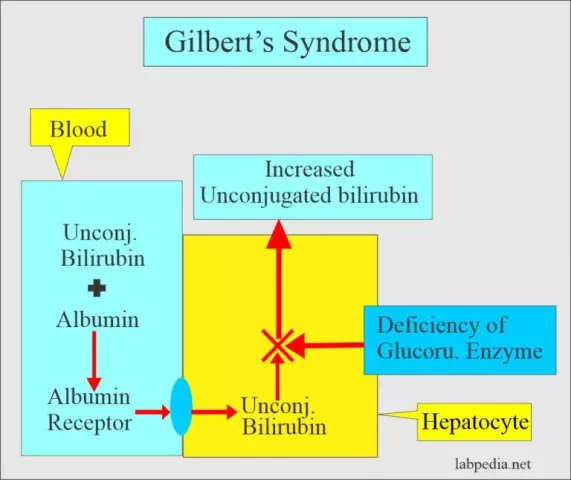- Author Rachel Wainwright [email protected].
- Public 2023-12-15 07:39.
- Last modified 2025-11-02 20:14.
Gilbert's syndrome

Gilbert's syndrome is a harmless hereditary disease that does not require special treatment. The disease is manifested by a periodic or constant increase in blood bilirubin, jaundice, as well as some other symptoms.
Causes of Gilbert's disease
The cause of the disease is a mutation of the gene responsible for the functioning of the liver enzyme - glucuronyl transferase. This is a special catalyst that is involved in the exchange of bilirubin, which is a breakdown product of hemoglobin. In conditions of a lack of glucuronyl transferase in Gilbert's syndrome, bilirubin cannot bind to the glucuronic acid molecule in the liver, and, as a consequence, its concentration in the blood increases.
Indirect (free) bilirubin poisons the body, especially the central nervous system. The neutralization of this substance is possible only in the liver and only with the help of a special enzyme, after which it is excreted in a bound form from the body with bile. In Gilbert's syndrome, bilirubin is reduced artificially with the help of special drugs.
The disease is inherited in an autosomal dominant manner, that is, when one of the parents is sick, the probability of having a child with the same syndrome is 50%.
The factors provoking an exacerbation of Gilbert's disease are:
- Taking certain medications - anabolic steroids and glucocorticoids;
- Excessive physical activity;
- Alcohol abuse;
- Stress;
- Operations and injuries;
- Viral and colds.
Diets, especially unbalanced diets, fasting, overeating, and fatty foods can cause Gilbert's syndrome.
Gilbert's syndrome symptoms
The general condition of people with this disease is usually satisfactory. Symptoms of Gilbert's syndrome include:
- The appearance of jaundice;
- Feeling of heaviness in the liver area;
- Intense pain in the right hypochondrium;
- Bitterness in the mouth, nausea, belching;
- Stool disorder (diarrhea or constipation);
- Bloating;
- Fatigue and poor sleep;
- Dizziness;
- Depressed mood.
Stressful situations (psychological or physical stress), infectious processes in the biliary tract or nasopharynx additionally provoke the appearance of these signs.
The main symptom of Gilbert's syndrome is jaundice, which can occur periodically (after exposure to certain factors), or be chronic. The degree of its severity is also different: from yellowness of the sclera only to a rather pronounced diffuse staining of the skin and mucous membranes. Sometimes there is pigmentation of the face, small yellowish plaques on the eyelids and scattered spots on the skin. In rare cases, even with increased bilirubin, jaundice is absent.
In 25% of sick people, an enlarged liver is detected. At the same time, it protrudes 1-4 cm from under the arch of the rib, the consistency is usual, when palpating the pain is not felt.
In 10% of patients, the spleen may be enlarged.
Diagnosis of the disease
Treatment of Gilbert's syndrome is preceded by its diagnosis. It is not difficult to detect this hereditary disease: the patient's complaints are taken into account, as well as the family history (identification of carriers or patients among close relatives).
To diagnose the disease, the doctor will prescribe a general blood and urine test. The presence of the disease is indicated by a reduced level of hemoglobin and the presence of immature red blood cells. There should be no changes in the urine, but if urobilinogen and bilirubin are found in it, this indicates the presence of hepatitis.
The following tests are also carried out:
- With phenobarbital;
- With nicotinic acid;
- With fasting.
For the last sample, the analysis for Gilbert's syndrome is carried out on the first day, and then two days later, during which the patient eats low-calorie food (no more than 400 kcal per day). An increase in the level of bilirubin by 50-100% indicates that a person really has this hereditary disease.
A test with phenobarbital involves taking a certain dose of the drug for five days. Against the background of such therapy, the level of bilirubin is significantly reduced.
The introduction of nicotinic acid is carried out intravenously. After 2-3 hours, the concentration of bilirubin increases several times.
Genetic analysis for Gilbert's syndrome
This method of diagnosing diseases with liver lesions accompanied by hyperbilirubinemia is the fastest and most effective method. It is a study of DNA, namely the UDFGT gene. If UGT1A1 polymorphism is found, the doctor confirms Gilbert's disease.
Genetic analysis for Gilbert's syndrome is also carried out in order to prevent hepatic crises. This test is recommended for people who have to take drugs with hepatotoxic effect.
Treatment for Gilbert's syndrome
As a rule, special treatment for Gilbert's syndrome is not required. If you follow the appropriate regimen, then the level of bilirubin remains normal or slightly elevated, without causing symptoms of the disease.
Patients should exclude heavy physical activity, give up fatty foods and alcohol-containing drinks. Long breaks between meals, fasting and taking certain medications (anticonvulsants, antibiotics, etc.) are undesirable.
Periodically, the doctor may prescribe a course of hepatoprotectors - drugs that have a positive effect on the liver. These include drugs such as Geptral, Liv 52, Hofitol, Essentiale Forte, Carsil and vitamins.

A diet for Gilbert's syndrome is a prerequisite, since a healthy diet and a favorable regime have a positive effect on the liver and the process of excreting bile. There should be at least four small meals a day.
With Gilbert's syndrome, the diet is allowed to include vegetable soups, low-fat cottage cheese, lean chicken and beef, crumbly cereals, wheat bread, non-acidic fruits, tea and compote. Products such as lard, fatty meats and fish, ice cream, fresh baked goods, spinach, sorrel, peppers and black coffee are prohibited.
You cannot completely exclude meat and adhere to vegetarianism, since with this type of diet, the liver will not receive the necessary amino acids.
In general, the prognosis for Gilbert's syndrome is favorable, since this disease can be considered one of the variants of the norm. People with this disease do not need treatment, and although elevated bilirubin levels persist for life, they do not increase mortality. Possible complications include chronic hepatitis and cholelithiasis.
For married couples where one of the spouses is the owner of this syndrome, before planning a pregnancy, it is necessary to consult a geneticist who will determine the likelihood of a disease in an unborn child.
There is no specific prevention of Gilbert's disease, since it is genetically determined, but by adhering to a healthy lifestyle and regularly undergoing medical examination, it is possible to timely stop diseases that provoke an exacerbation of the syndrome.
YouTube video related to the article:
The information is generalized and provided for informational purposes only. At the first sign of illness, see your doctor. Self-medication is hazardous to health!






